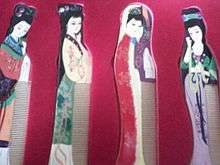Four Beauties

| Four Beauties | |||||||||||||||
| Chinese | 四大美女 | ||||||||||||||
|---|---|---|---|---|---|---|---|---|---|---|---|---|---|---|---|
| |||||||||||||||
| Four Great Beauties | |||||||||||||||
| Chinese | 四大美人 | ||||||||||||||
| |||||||||||||||
The Four Beauties or Four Great Beauties are four Chinese women, renowned for their beauty. These were Xi Shi, Wang Zhaojun, Diaochan, and Yang Guifei.[1] The scarcity of historical records concerning them meant that much of what is known of them today has been greatly embellished by legend. They all were said to have in some manner caught the attention of a ruling king or emperor in their respective eras.[1] They gained their reputation from the influence they exercised over kings and emperors and, consequently, the way their actions impacted Chinese history. Three of the Four Beauties brought kingdoms to their knees and their lives ended in tragedy.
The Beauties
The Four Great Beauties lived in four different dynasties, each hundreds of years apart. In chronological order, they are:
- Xi Shi (c. 7th to 6th century BC, Spring and Autumn period), said to be so entrancingly beautiful that fish would forget how to swim and sink below the surface upon seeing her reflection in the water.[2] Xi Shi's hometown is Zhuji, Zhejiang Province. Zhuji was the capital of Ancient Yue Kingdom. Gou Jian, the King of Yue Kingdom, endured ten years hardship (sleeping on brushwood and tasting the gall) to accomplish his ambition to beat Fu Chai, the King of Wu Kingdom. Xi Shi was part of his plan. Despite that Xi Shi had Fan Li as the man of her dreams, Gou Jian sent Xi Shi as a gift to Fu Chai who was dazzled by her beauty and fell in love with her. Fu Chai lost his fighting will after he met Xi Shi but spending his time entertaining with Xi Shi. Finally, Gou Jian defeated Fu Chai.
- Wang Zhaojun (c. 1st century BC, Western Han Dynasty), said to be so beautiful that her appearance would entice birds in flight to fall from the sky.[3]
- Diaochan (c. 3rd century, Late Eastern Han/Three Kingdoms period), said to be so luminously lovely that the moon itself would shy away in embarrassment when compared to her face.[4] Unlike the other Beauties, there is no evidence she actually existed historically.
- Yang Guifei (719–756, Tang Dynasty), said to have a face that puts all flowers to shame.
Idiom
Well-known idioms describe the Four Beauties.[5] The exact origin of these idioms is debated.
| Chinese | English |
|---|---|
| 西施沉魚 昭君落雁 貂蟬閉月 貴妃羞花 |
Xi Shi sinks fish Wang Zhaojun entices birds into falling Diaochan eclipses the moon Yang Guifei shames flowers |
These separate idioms are sometimes merged to describe especially beautiful women or simply to refer to the Four Beauties' legendary good looks. The merged idiom is 沉魚落雁, 閉月羞花 (sinks fish and entices birds to fall, eclipses the moon and shames flowers); the two parts can also be used separately.
References
| Wikimedia Commons has media related to Four Great Beauties. |
- 1 2 Woo, X.L. (2016). Love Tales of Ancient China. Algora. pp. 1–4. ISBN 978-1-62894-204-0.
- ↑ Big5.ce.cn. "Big5.ce.cn Archived 2011-07-25 at the Wayback Machine.." 西施浣紗——沉魚. Retrieved on 2010-02-20.
- ↑ Big5.ce.cn. "Big5.ce.cn Archived 2011-07-25 at the Wayback Machine.." 昭君出塞——落雁. Retrieved on 2010-02-20.
- ↑ Big5.ce.cn. "Big5.ce.cn Archived 2011-07-25 at the Wayback Machine.." 貂蟬拜月——閉月. Retrieved on 2010-02-20.
- ↑ Xinhuanet.com. "Xinhuanet.com Archived 2013-02-06 at WebCite." 纪连海叹说四大美人 . Retrieved on 2010-02-20.